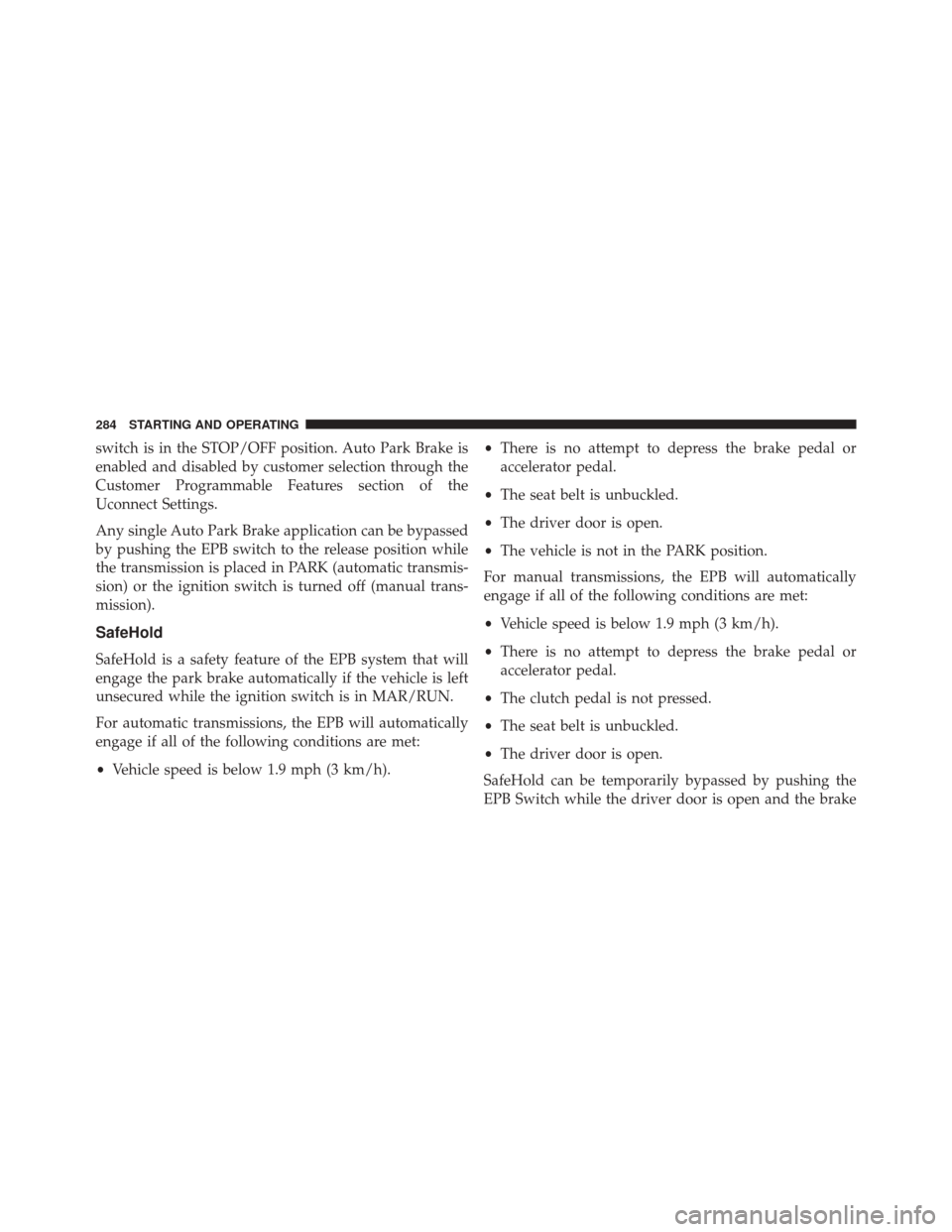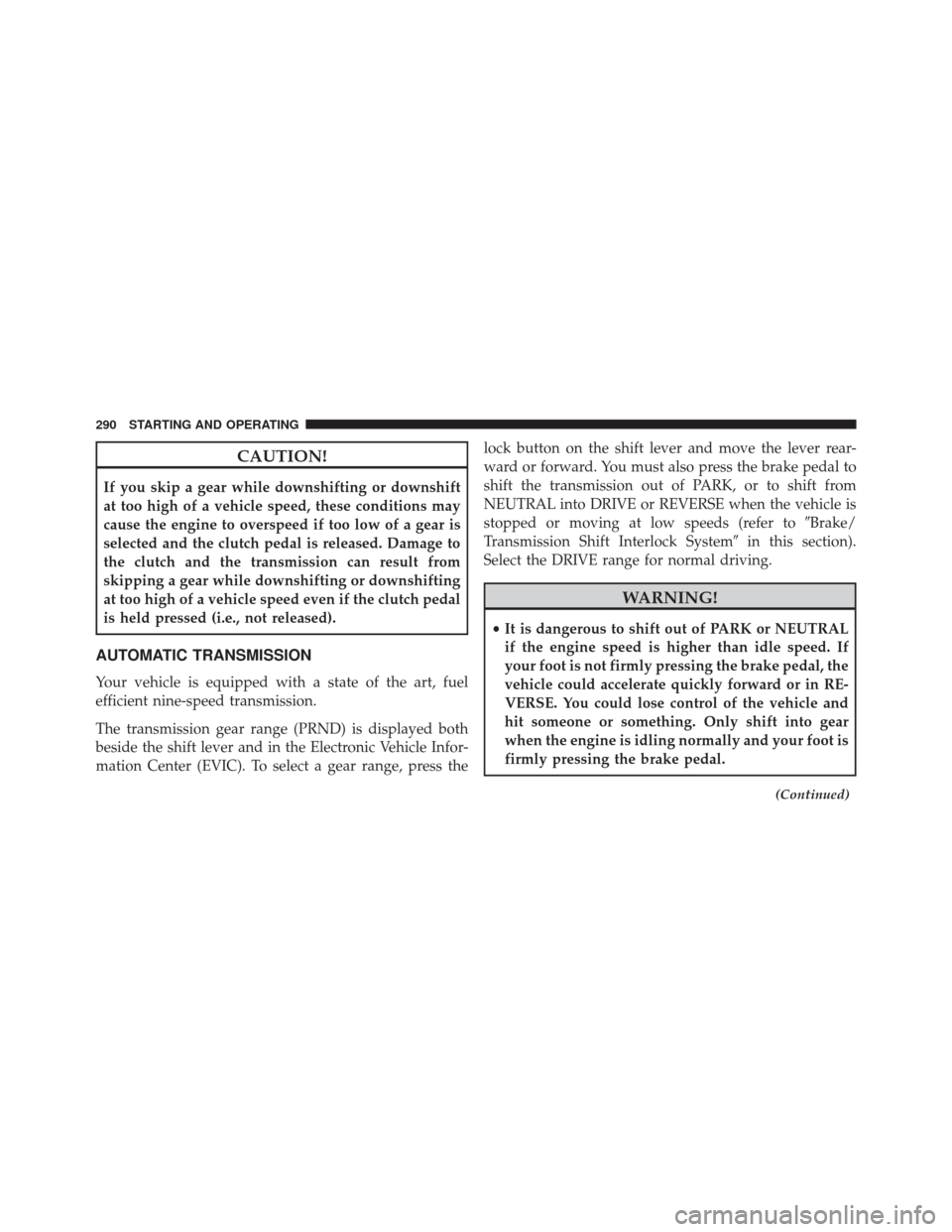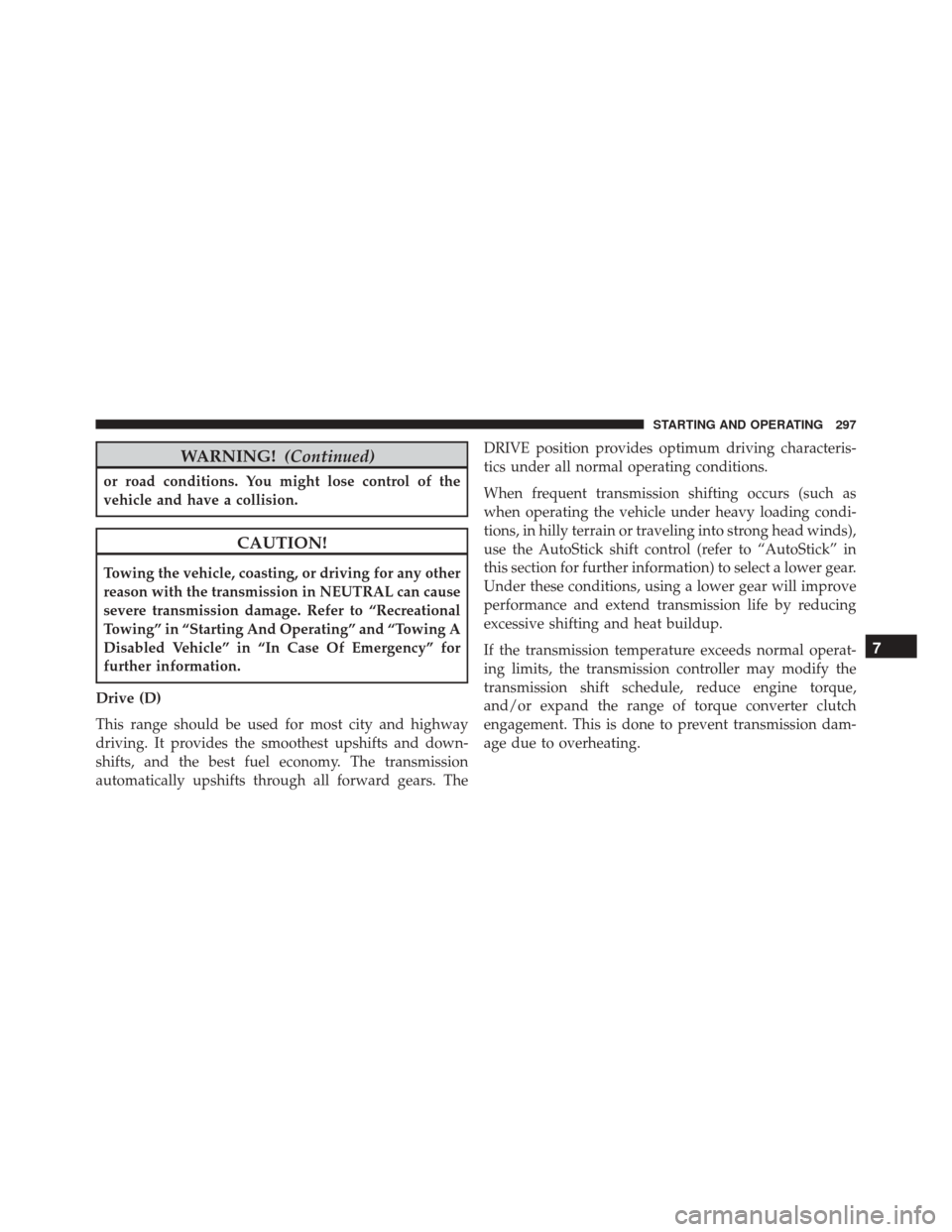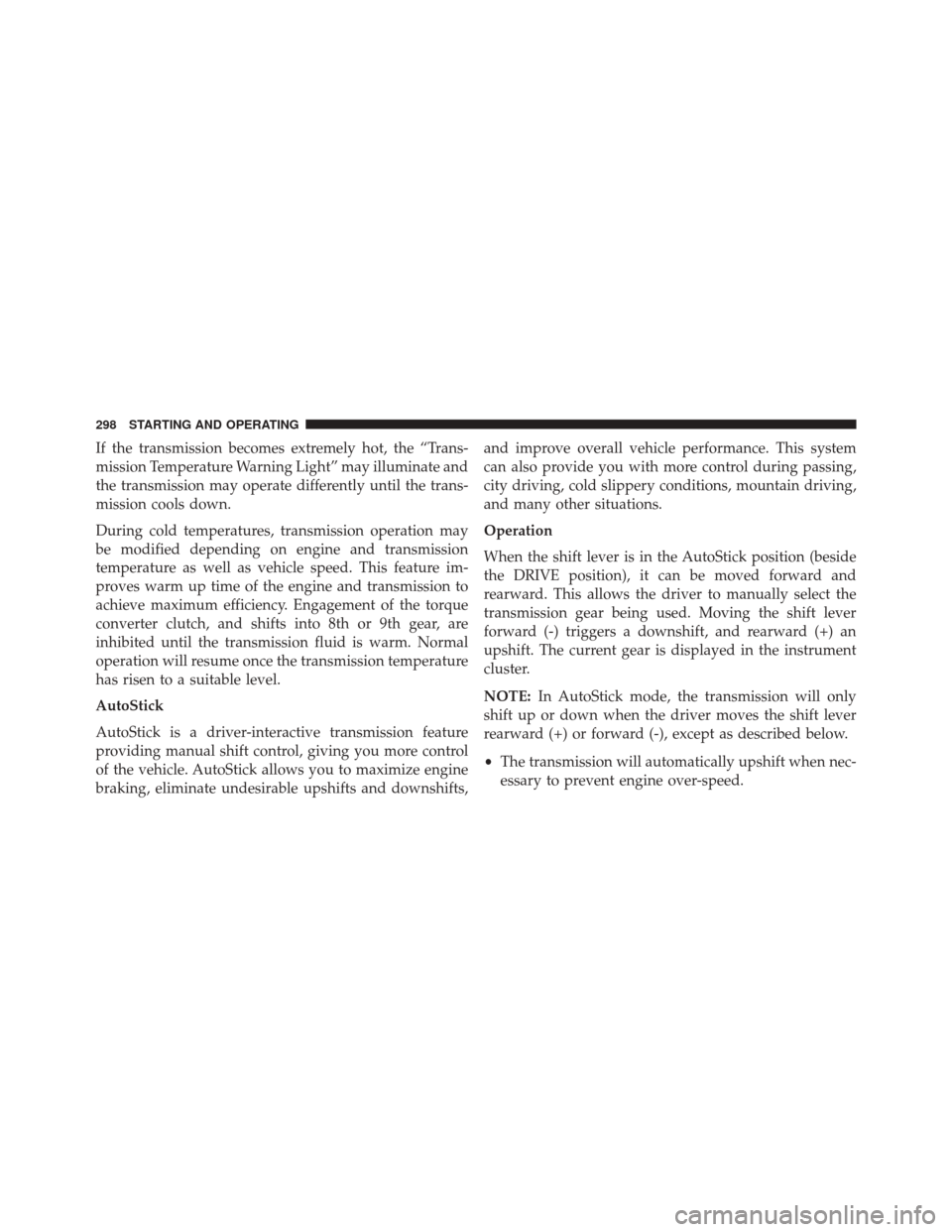Page 286 of 587

switch is in the STOP/OFF position. Auto Park Brake is
enabled and disabled by customer selection through the
Customer Programmable Features section of the
Uconnect Settings.
Any single Auto Park Brake application can be bypassed
by pushing the EPB switch to the release position while
the transmission is placed in PARK (automatic transmis-
sion) or the ignition switch is turned off (manual trans-
mission).
SafeHold
SafeHold is a safety feature of the EPB system that will
engage the park brake automatically if the vehicle is left
unsecured while the ignition switch is in MAR/RUN.
For automatic transmissions, the EPB will automatically
engage if all of the following conditions are met:
•Vehicle speed is below 1.9 mph (3 km/h). •
There is no attempt to depress the brake pedal or
accelerator pedal.
• The seat belt is unbuckled.
• The driver door is open.
• The vehicle is not in the PARK position.
For manual transmissions, the EPB will automatically
engage if all of the following conditions are met:
• Vehicle speed is below 1.9 mph (3 km/h).
• There is no attempt to depress the brake pedal or
accelerator pedal.
• The clutch pedal is not pressed.
• The seat belt is unbuckled.
• The driver door is open.
SafeHold can be temporarily bypassed by pushing the
EPB Switch while the driver door is open and the brake
284 STARTING AND OPERATING
Page 292 of 587

CAUTION!
If you skip a gear while downshifting or downshift
at too high of a vehicle speed, these conditions may
cause the engine to overspeed if too low of a gear is
selected and the clutch pedal is released. Damage to
the clutch and the transmission can result from
skipping a gear while downshifting or downshifting
at too high of a vehicle speed even if the clutch pedal
is held pressed (i.e., not released).
AUTOMATIC TRANSMISSION
Your vehicle is equipped with a state of the art, fuel
efficient nine-speed transmission.
The transmission gear range (PRND) is displayed both
beside the shift lever and in the Electronic Vehicle Infor-
mation Center (EVIC). To select a gear range, press thelock button on the shift lever and move the lever rear-
ward or forward. You must also press the brake pedal to
shift the transmission out of PARK, or to shift from
NEUTRAL into DRIVE or REVERSE when the vehicle is
stopped or moving at low speeds (refer to
�Brake/
Transmission Shift Interlock System �in this section).
Select the DRIVE range for normal driving.
WARNING!
• It is dangerous to shift out of PARK or NEUTRAL
if the engine speed is higher than idle speed. If
your foot is not firmly pressing the brake pedal, the
vehicle could accelerate quickly forward or in RE-
VERSE. You could lose control of the vehicle and
hit someone or something. Only shift into gear
when the engine is idling normally and your foot is
firmly pressing the brake pedal.
(Continued)
290 STARTING AND OPERATING
Page 299 of 587

WARNING!(Continued)
or road conditions. You might lose control of the
vehicle and have a collision.
CAUTION!
Towing the vehicle, coasting, or driving for any other
reason with the transmission in NEUTRAL can cause
severe transmission damage. Refer to “Recreational
Towing” in “Starting And Operating” and “Towing A
Disabled Vehicle” in “In Case Of Emergency” for
further information.
Drive (D)
This range should be used for most city and highway
driving. It provides the smoothest upshifts and down-
shifts, and the best fuel economy. The transmission
automatically upshifts through all forward gears. The DRIVE position provides optimum driving characteris-
tics under all normal operating conditions.
When frequent transmission shifting occurs (such as
when operating the vehicle under heavy loading condi-
tions, in hilly terrain or traveling into strong head winds),
use the AutoStick shift control (refer to “AutoStick” in
this section for further information) to select a lower gear.
Under these conditions, using a lower gear will improve
performance and extend transmission life by reducing
excessive shifting and heat buildup.
If the transmission temperature exceeds normal operat-
ing limits, the transmission controller may modify the
transmission shift schedule, reduce engine torque,
and/or expand the range of torque converter clutch
engagement. This is done to prevent transmission dam-
age due to overheating.
7
STARTING AND OPERATING 297
Page 300 of 587

If the transmission becomes extremely hot, the “Trans-
mission Temperature Warning Light” may illuminate and
the transmission may operate differently until the trans-
mission cools down.
During cold temperatures, transmission operation may
be modified depending on engine and transmission
temperature as well as vehicle speed. This feature im-
proves warm up time of the engine and transmission to
achieve maximum efficiency. Engagement of the torque
converter clutch, and shifts into 8th or 9th gear, are
inhibited until the transmission fluid is warm. Normal
operation will resume once the transmission temperature
has risen to a suitable level.
AutoStick
AutoStick is a driver-interactive transmission feature
providing manual shift control, giving you more control
of the vehicle. AutoStick allows you to maximize engine
braking, eliminate undesirable upshifts and downshifts,and improve overall vehicle performance. This system
can also provide you with more control during passing,
city driving, cold slippery conditions, mountain driving,
and many other situations.
Operation
When the shift lever is in the AutoStick position (beside
the DRIVE position), it can be moved forward and
rearward. This allows the driver to manually select the
transmission gear being used. Moving the shift lever
forward (-) triggers a downshift, and rearward (+) an
upshift. The current gear is displayed in the instrument
cluster.
NOTE:
In AutoStick mode, the transmission will only
shift up or down when the driver moves the shift lever
rearward (+) or forward (-), except as described below.
• The transmission will automatically upshift when nec-
essary to prevent engine over-speed.
298 STARTING AND OPERATING
Page 301 of 587

•The transmission will automatically downshift as the
vehicle slows (to prevent engine lugging) and will
display the current gear.
• The transmission will automatically downshift to first
or second gear (depending on model) when coming to
a stop. After a stop, the driver should manually upshift
(+) the transmission as the vehicle is accelerated.
• You can start out (from a stop) in first or second gear.
Starting out in second gear can be helpful in snow or
icy conditions. Tap the shift lever forward or rearward
to select the desired gear after the vehicle is brought to
a stop.
• If a requested downshift would cause the engine to
over-speed, that shift will not occur.
• The system will ignore attempts to upshift at too low
of a vehicle speed. •
Avoid using speed control when AutoStick is engaged
because the transmission will not shift automatically.
• Transmission shifting will be more noticeable when
AutoStick is engaged.
• The system may revert to automatic shift mode if a
fault or overheat condition is detected.
To disengage AutoStick mode, return the shift lever to the
DRIVE position. You can shift in or out of the AutoStick
position at any time without taking your foot off the
accelerator pedal.
WARNING!
Do not downshift for additional engine braking on a
slippery surface. The drive wheels could lose their
grip and the vehicle could skid, causing a collision or
personal injury.
7
STARTING AND OPERATING 299
Page 309 of 587

All Weather Mode –This mode offers increased traction
control and stability control for low traction conditions
such as driving in snow or rain.
Sport Mode – This mode is designed to increase steering
feedback to the driver with a slight increase in effort and
changes the transmission shift schedules for more aggres-
sive shifting. This driving mode is useful while driving
on twisty roads where more steering precision is desired
in spirited cornering.
Warning Messages
In the event of a system fault, the system automatically
defaults to �Auto�mode and a message will appear in the
EVIC display.
Refer to “Electronic Vehicle Information Center (EVIC)”
in “Getting To Know Your Instrument Cluster” for fur-
ther information.
BRAKE CONTROL — IF EQUIPPED
Brake Control
The Brake Control system with mitigation provides the
driver with audible warnings, visual warnings (within
the EVIC), and may apply a brake jerk to warn the driver
when it detects a potential frontal collision. The warnings
and limited braking are intended to provide the driver
with enough time to react, avoid or mitigate the potential
collision.
NOTE:
• Brake Control monitors the information from the for-
ward looking sensors as well as the Electronic Brake
Controller (EBC), to calculate the probability of a
forward collision. When the system determines that a
forward collision is probable, the driver will be pro-
vided with audible and visual warnings and may
provide a brake jerk warning.
7
STARTING AND OPERATING 307
Page 310 of 587

•If the driver does not take action based upon these
progressive warnings, then the system will provide a
limited level of active braking to help slow the vehicle
and mitigate the potential forward collision. If the
driver reacts to the warnings by braking and the
system determines that the driver intends to avoid the
collision by braking but has not applied sufficient
brake force, the system will compensate and provide
additional brake force as required.
Vehicles With A Manual Transmission: After the end of
the intervention of automatic braking, the engine could
stall, unless the driver can depress the clutch pedal.
Vehicles With Automatic Transmission: After the end of
the intervention of automatic braking, the transmission
may remain in last gear stored: therefore the car could
lurch forward, once the brakes release a few seconds
later. If the Brake Control event stops the vehicle com-
pletely, the system will hold the vehicle at standstill for
two seconds and then release the brakes. If a Brake Control event begins at a speed below 20 mph
(32 km/h), the system may provide the maximum brak-
ing possible to mitigate the potential forward collision. If
the Brake Control event stops the vehicle completely, the
system will hold the vehicle at standstill for two seconds
and then release the brakes.
Brake Control Message
308 STARTING AND OPERATING
Page 353 of 587
RECREATIONAL TOWING (BEHIND MOTORHOME, ETC.)
Towing This Vehicle Behind Another Vehicle
FRONT WHEEL DRIVE (FWD)ALL-WHEEL
DRIVE (AWD)
TOWING
CONDITION WHEELS OFF THE
GROUND AUTOMATIC
TRANSMISSION MANUAL
TRANSMISSION MANUAL/
AUTOMATIC
TRANSMISSION
Flat Tow NONE NOT ALLOWED NOT ALLOWED NOT ALLOWED
Dolly Tow REARNOT ALLOWED NOT ALLOWED NOT ALLOWED
FRONT OKOKNOT ALLOWED
On Trailer ALLBEST METHOD BEST METHOD OK
NOTE: When recreationally towing your vehicle, always follow applicable state and provincial laws. Contact
state and provincial Highway Safety offices for additional details.
7
STARTING AND OPERATING 351